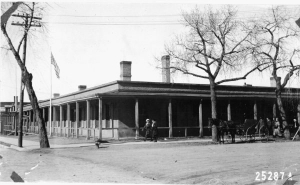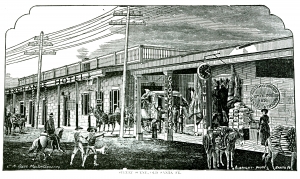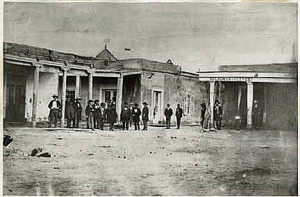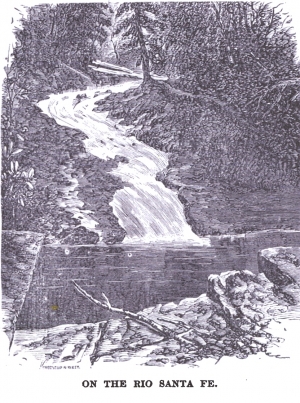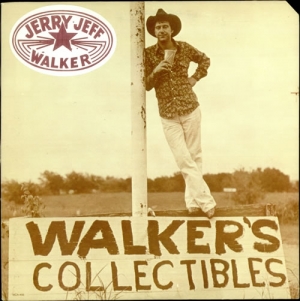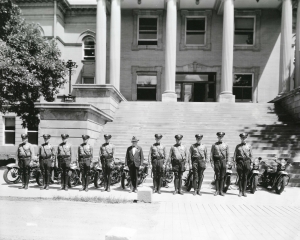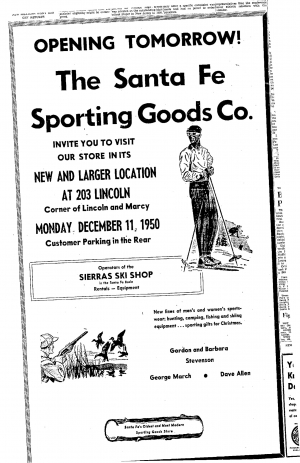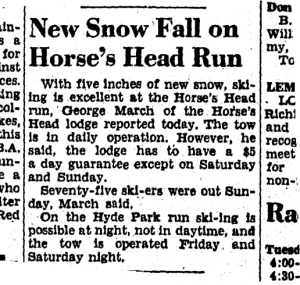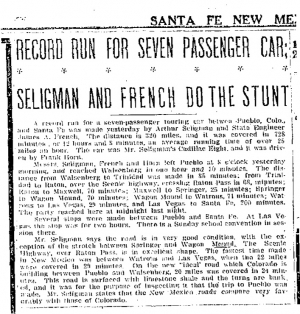Arthur Scott
Old Barracks 1915
U. S Forest Service Photo. Taken by A. J. Connell in 19915. Captioned "Former Forest Supervisor's office. Just about to be torn down to provide room for the catheedral of the desert" (Art Museum of New Mexico)
Seligman Brothers--Pioneer Jewish entrepreneurs of Santa Fe and the New Mexico Territory
Seligman Brothers--Pioneer Jewish entrepreneurs of Santa Fe and the New Mexico Territory
by
Arthur (Seligman) Scott
Please see my article describing the lives of the three original Seligman Brothers, German Jewish immigrants to Santa Fe. Sigmund immigrated to Santa Fe in 1849 and entered a wholesale-retail mercantile business a year before New Mexico even became a U. S. Territory and while it was still under US Military rule. The business consisted of buying goods in the east and sending them to Santa Fe by wagon to be sold in Santa Fe. The Seligman Brothers store lasted well over a hundred years on the Santa Fe Plaza.
The article is posted on the website of The New Mexico State Historian, reached by the following link: http://www.newmexicohistory.org/people/seligman-brothers-pioneer-jewish-entrepreneurs-of-santa-fe-and-the-new-mexi
My Grandfather's Birthplace on the Santa Fe Plaza
My Grandfather's Birthplace on the Santa Fe Plaza
by
Arthur Scott
I recently discovered that my grandfather, Arthur Seligman, was born in 1881 on the Plaza in Santa Fe. According to Ralph Emerson Twitchell's "Old Santa Fe," published in 1925, Arthur was born to Bernard and Frances Seligman in the residence in the rear of the Siligman-Cllever (Seligman Brothers) store. Later this location was advertised as "The end of the Santa Fe Trail" As an infant Arthur made three trips with his mother over the trail. The view in the 1855 photograph is looking at the corner of present day San Francisco and Old Santa Fe Trail. This street has carried the names of "Santa Fe Trail, Seligman Street, Shelby Street, and Old Santa Fe Trail."
The store is shown above on the right in what William Stone (New Mexico Them and Nowe) calls the oldest photo found of Santa Fe. He also noted that Sigmund Seligman, my great uncle, was the first photographer in New Mexico. Before entering the mercantile business in 1852, he ran a daguerreotype portrait studio for a short time in Santa Fe. To the left is the Exchange Hotel, the only lodgings in Santa Fe at the time of the photo..
Reviw of The Replacement Child by Christine Barber
A Review
by
Arthur Scott
The Replacement Child
by
Christine Barber
I found this novel, published in 2008, to be an extremely entertaining novel. It is basically a murder mystery that takes place in Santa Fe and Toas. The book is a "who- done-it" to the end and the novel was a winner of the Tony Hillerman prize.
The author has the credentials and eye to capture the nuance of the Angelo and Hispanic culture of northern New Mexico. In 2008 she was living in Albuquerque perusing a career in medicine.. She also had been an editor at TheSanta Fe New Mexican and a journalist for the Albuquerque Journal and the Gallup Independent.
Santa Fe River/water-supply Canon de Santa Fe
Rio Santa Fe y Canon de Santa Fe—Santa Fe’s Life Blood
And My Personal Misadventures in the River
By
Arthur Scott
In 1610 the Spanish colonists (Peralta) that choose the location most likely did so by first and foremost considering the availability of an assumed perennial water supply. Other considerations such as flat arable land (river flood plain) and defensive position against raiding Indians would be secondary. . Upper Santa Fe Canyon would have provided other resources such as timber, fish, and game. For over four hundred years the water supply of the Rio Santa Fe has met most of the city’s needs. Twice battles for Santa Fe were decided by the river. In 1680 the Pueblo Indians drove the hated Spaniards from the capitol by simply diverting the acequia being fed by the Rio, the city’s single water supply. Thirteen years later De Vargas used the same tactic to conquer the Indians remaining in Santa Fe.
After the ceding of New Mexico to the United States from Mexico in 1846 and the opening of the Santa Fe Trail for immigration and commerce, the need for potable water increased and as with most water supplies, a competing need for agricultural use. Santa Fe canyon also served the townspeople as a recreation area and as a homesteading location.
All of the following photographs, illustrating the early 1900’s Santa Fe Canyon were taken from Frost, Max and Walter, Paul A. F., 1906, The Land Of Sunshine, New Mexico Bureau Of Immigration The Land of Sunshine by the Territorial Bureau of Immigration which was published in 1906 to be distributed at the Louisiana Purchase exposition in Saint Louis in 1906. The publication was designed to lure eastern state immigrants to New Mexico by documenting mining and agricultural opportunities and to dispel the notion that the Territory is a desolate, dry desert by using many photos of streams, reservoirs, dams, and artisan wells.
Me and Jerry Jeff
Me And Jerry Jeff
by
Arthur Scott
Way back in the olden days, early 70's, I was really into the folk revival and the "outlaw" country trends in music. Some of the folks I really enjoyed at the time were Kris Kristofferson (still a favorite for his poetic lyrics) , among the "outlaws" (those whom fled the Nashville record corporations for the recording freedom of Austin, Texas; were Willie Nelson, Waylon Jennings, B. W. Stephenson, Ray Wiley Hubbard along with several others. A sort of cult favorite was Jerry Jeff Walker (actually from New York but adopted Texas as home as well as the name "Jerry Jeff Walker") and the Lost Gonzo Band. He was a successful song writer and had written "Mr. Bojangles" which was covered by many artists over the years.
Santa Fe was not then noted as a concert town. I do remember taking a date in high school to a
New Mexico Motor Patrol
The New Mexico Motor Patrol
by
Arthur Scott
The New Mexico Motor Patrol, from 1933 to 1935, was the predecessor of the New Mexico State Police which was authorized in 1935. From 1921 to 1933 New Mexico did not have any statewide law enforcement agency. The 1933 legislature and governor created the Motor Patrol to serve this purpose.
The June 3, 1933 New Mexican states in part:
"231 SEEKING PATROL JOBS
The motor patrol has 231 aspirants who have filled out and returned the original questionnaires sent out by the board.
Of these, however, a number are too short, some too heavy, others suffering from maladies which prevent their acceptance. and of the231, there probably will not be more than a third eligible for the next examination, board members said.
Dates will be fixed and places assigned and the applicants meeting other requirements will assemble for a "30-minute test" which is in the form of question and answer and contains several problems each to indicate the man's worth in his endeavor."
The resulting force were the ten men shown above with my grandfather, Governor Arthur Seligman taken on the August 5, 1933 inauguration of the New Mexico Motor Patrol. This state photo was taken just about six weeks before he died suddenly on September 25, 1933.
The Motor Patrol continued to do their job until 1935 when the New Mexico State Police were created by the state legislature. Examples of their work are described in the following article published in the August 10, 1933 New Mexican: Note Patrolman Lacy Shortridge got bucked off in Tijeras Canyon.

Santa Fe Sporting Goods 1950
Before Santa Fe Ski Basin 1942
My primo George March. This was before he enlisted in the Army ski troops and then lost both legs in Italy.
He was also stationed in the Alutians and taught mountain climbing at Ft Carson.
Record auto run to Santa Fe Jun 9, 1916
Record set for 1916, seven passenger Cadillac touring car. From Pueblo. CO to Santa Fe in 728 minuets.












